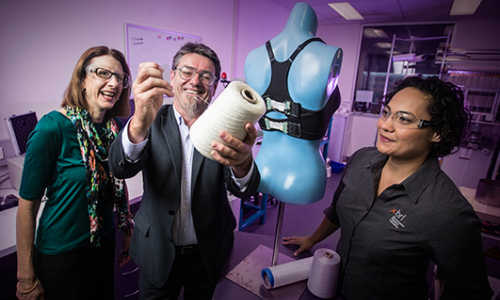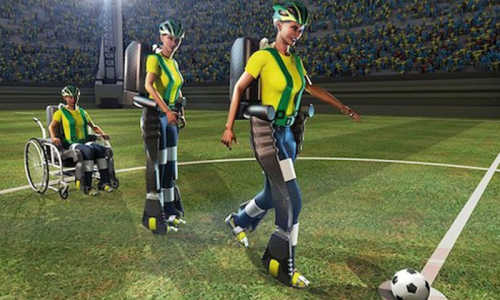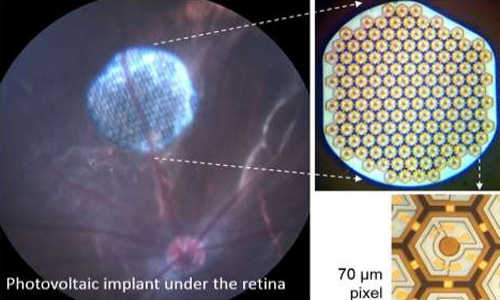The bra, made using intelligent components, will be discussed at the 9th Australasian Biomechanics Conference (ABC9) at UOW from Sunday 30 November to Tuesday 2 December. Work first started on the Bionic Bra more than fifteen years ago. However, technology is only starting to catch up with the researchers’ imaginations.
From left: Professor Julie Steele, Professor Gordon Wallace and Dr Sheridan Gho with the ‘smart yarn’ used to create the Bionic Bra.
Professor Gordon Wallace, Executive Research Director of the Australian Research Council Centre of Excellence for Electromaterials Science based at UOW, said the Bionic Bra team has recently discovered new actuators and sensing technologies that will bring the bra to life.
“Our ability to make things from advanced materials has been greatly enhanced recently with the advent of new approaches to fabrication. The advent of approaches such as 3D printing has enabled us to assemble structures containing new sensing technologies to more accurately monitor movement and new artificial muscle technologies to control it. These advances have inspired us to (re)confront the challenges involved in creating the Bionic Bra,” Professor Wallace said.
Professor Julie Steele, Director of Breast Research Australia (BRA) based at UOW, has been working with Professor Wallace on the bra since its inception. She has also been investigating the movement of women’s breast during physical activity for more than 15 years. She said without the right breast support, long-term damage can be done, including numbness in the fingers caused by compression of nerves on the shoulders, as well as neck and back pain.
“Unfortunately, the most supportive sports bras tend to be the most uncomfortable to wear. Making matters worse, BRA research has found that 85 per cent of women are wearing bras that do not fit or support their breasts correctly.”
While vast improvements have been made recently to the design of the Bionic Bra, the researchers say there are still some kinks to iron out.
“Although we have made substantial progress, we still have a way to go before the Bionic Bra can be taken from the bench top to the washing machine. However, when finished, the Bionic Bra will transform bra design,” Professor Steele said.
“Results indicate that our technologies can sense breast motion and provide additional breast support. The challenge now is to integrate these technologies into a functional, comfortable bra,” Bionic Bra team member Dr Sheridan Gho said.
Professor Wallace will describe recent Bionic Bra developments in the Opening Keynote Address of the 9th Australasian Biomechanics Conference. Research to measure the effectiveness of rugby headgear, rethink the rules around junior fast bowlers in cricket and assess risk of injury in aerial surfing will also be discussed at the Conference.
Story Source:
The above story is based on materials provided by University of Wollongong.





